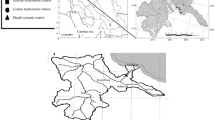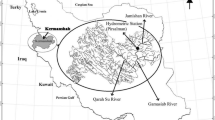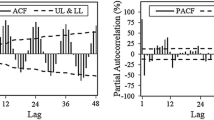Abstract
The optimal operation of dam reservoirs can be programmed and managed by predicting the inflow to these structures more accurately. To this end, there are various linear and nonlinear models. However, some hydrological problems like inflow with extreme seasonal variation are not purely linear or nonlinear. To improve the forecasting accuracy of this phenomenon, a linear Seasonal Auto Regressive Integrated Moving Average (SARIMA) model is combined with a nonlinear Artificial Neural Network (ANN) model. This new model is used to predict the monthly inflow to the Jamishan dam reservoir in West Iran. A comparison of the SARIMA and ANN models with the proposed hybrid model’s results is provided accordingly. More specifically, the models’ performance in forecasting base and flood flows is evaluated. The effect of changing the forecasting period length on the models’ accuracy is studied. The results of increasing the number of SARIMA model parameters up to five are investigated to achieve more accurate forecasting. The hybrid model predicts peak flood flows much better than the individual models, but SARIMA outperforms the other models in predicting base flow. The obtained results indicate that the hybrid model reduces the overall forecast error more than the ANN and SARIMA models. The coefficient of determination of the hybrid, ANN and SARIMA models were 0.72, 0.64 and 0.58, and the root mean squared error values were 1.02, 1.16 and 1.27 respectively, during the forecast period. Changing the forecasting length also indicated that these models can be used in the long term without increasing the forecast error.









Similar content being viewed by others
References
Abebe A, Foerch G (2008) Stochastic simulation of the severity of hydrological drought. Water Environ J 22(1):2–10
Aladag CH, Egrioglu E, Kadilar C (2012) Improvement in forecasting accuracy using the hybrid model of ARFIMA and feed forward neural network. Am J Intell Syst 2(2):12–17
Anctil F, Perrin C, Andreassian V (2004) Impact of the length of observed records on the performance of ANN and of conceptual parsimonious rainfall-runoff forecasting models. Environ Modell Softw 19(4):357–368
Box GE, Cox DR (1964) An analysis of transformations. J R Stat Soc B Met 26:211–252
Box GEP, Jenkins GM (1976) Time series analysis: forecasting and control. Holden-Day, San Francisco
Box GE, Pierce DA (1970) Distribution of residual autocorrelations in autoregressive-integrated moving average time series models. J Am Stat Assoc 65(332):1509–1526
Cantet P, Bacro JN, Arnaud P (2011) Using a rainfall Stochastic generator to detect trends in extreme rainfall. Stoch Environ Res Risk A 25(3):429–441
Coulibaly P, Anctil F, Bobee B (2000) Daily reservoir inflow forecasting using artificial neural networks with stopped training approach. J Hydrol 230(3):244–257
Cryer JD, Chan KS (2008) Time series analysis, with applications in R, 2nd edn. Springer, New York
Damle C, Yalcin A (2007) Flood prediction using time series data mining. J Hydrol 333(2):305–316
Durdu ÖF (2010) Application of linear stochastic models for drought forecasting in the Büyük Menderes river basin, western Turkey. Stoch Environ Res Risk A 24(8):1145–1162
Faruk DO (2010) A hybrid neural network and SARIMA model for water quality time series prediction. Eng Appl Artif Intell 23(4):586–594
Fereydooni M, Rahnemaei M, Babazadeh H, Sedghi H, Elhami MR (2012) Comparison of artificial neural networks and stochastic models in river discharge forecasting, Case study, Ghara-Aghaj river, Fars Province, Iran. Afr J Agric Res 7(40):5446–5458
Firat M (2008) Comparison of artificial intelligence techniques for river flow forecasting. Hydrol Earth Syst Sci 12(1):123–139
Firat M, Güngör M (2010) Monthly total sediment forecasting using adaptive neuro fuzzy inference system. Stoch Environ Res Risk A 24(2):259–270
Golabi MR, Radmanesh F, Akhondali AM, Kashefipoor M (2013) Simulation of seasonal precipitation using ANN and SARIMA models, a case study of (Iran) Khozestan. Elixir Comput Sci Eng 55:13039–13046
He HD, Lu WZ (2012) Spectral analysis of vehicle pollutants at traffic intersection in Hong Kong. Stoch Environ Res Risk A 26(8):1053–1061
Hipel KW, McLeod AI, Lennox WC (1977) Advances in Box-Jenkins modeling, 1, model construction. Water Resour Res 13(3):567–575
Hirsch RM, Slack JR (1984) A nonparametric trend test for seasonal data with serial dependence. Water Resour Res 20:727–732
Hurst HE, Black RP, Simaika YM (1965) Long-term storage, an experimental study. Constable Press, London
Jain SK, Das A, Srivastava DK (1999) Application of ANN for reservoir inflow prediction and operation. J Water Res Plan ASCE 125(5):263–271
Jarque CM, Bera AK (1980) Efficient tests for normality, homoscedasticity and serial independence of regression residuals. Econ Lett 6(3):255–259
Jeong K, Koo C, Hong T (2014) An estimation model for determining the annual energy cost budget in educational facilities using SARIMA (seasonal autoregressive integrated moving average) and ANN (artificial neural network). Energy 71:71–79
Khashei M, Bijari M (2010) An artificial neural network (p, d, q) model for time series forecasting. Expert Syst Appl 37(1):479–489
Khatibi R, Ghorbani MA, Naghipour L, Jothiprakash V, Fathima TA, Fazelifard MH (2014) Inter-comparison of time series models of lake levels predicted by several modeling strategies. J Hydrol 511:530–545
Kisi Ö (2004) River flow modeling using artificial neural networks. J Hydrol Eng 9(1):60–63
Kisi I, Cigizoglu K (2005) Reservoir management using artificial neural networks. 14th Reg Directorate of DSI State Hydraulic Works, Istanbul
Kisi O, Cigizoglu HK (2007) Comparison of different ANN techniques in river flow prediction. Civ Eng Environ Sys 24(3):211–231
Koutroumanidis T, Loannou K, Arabatzis G (2009) Predicting fuelwood prices in Greece with the use of SARIMA models, artificial neural networks and a hybrid SARIMA–ANN model. Energy Policy 37(9):3627–3634
Levenberg K (1944) A method for the solution of certain non-linear problems in least squares. Quart Appl Math 2:164–168
Martins VLM, Werner L (2012) Forecast combination in industrial series: a comparison between individual forecasts and its combinations with and without correlated errors. Expert Syst Appl 39(13):11479–11486
McLeod A (1978) On the distribution of residual autocorrelations in Box-Jenkins models. J R Stat Soc B Met 40(3):296–302
Mohammadi K, Eslami HR, Dardashti SH (2005) Comparison of regression, SARIMA and ANN models for reservoir inflow forecasting using snowmelt equivalent a case study of Karaj. J Agric Sci Technol 7:17–30
Nirmala M, Sundaram SM (2010) Modeling and predicting the monthly rainfall in Tamil Nadu as a seasonal multivariate SARIMA process. Int J Comput Eng 1:103–111
Nourani V, Kisi O, Komasi M (2011) Two hybrid artificial intelligence approaches for modeling rainfall–runoff process. J Hydrol 402(1):41–59
Pektas AO, Cigizoglu HK (2013) ANN hybrid model versus SARIMA and SARIMAX models of runoff coefficient. J Hydrol 500:21–36
Peña D, Tiao GC, Tsay RS (2011) A course in time series analysis. Wiley, New York
Ruiz-Aguilar J, Turias I, Jiménez-Come M (2015) A novel three-step procedure to forecast the inspection volume transport. Res C-Emerg 56:393–414
Salas JD, Delleur JW, Yevjevich V, Lane WL (1988) Applied modeling of hydrologic time series. Water Resources Publication, Highlands Ranch
Shao Q, Li Z, Xu Z (2010) Trend detection in hydrological time series by segment regression with application to Shiyang River Basin. Stoch Environ Res Risk A 24(2):221–233
Tao H, Fraedrich K, Menz C, Zhai J (2014) Trends in extreme temperature indices in the Poyang Lake Basin, China. Stoch Environ Res Risk A 28(6):1543–1553
Tongal H, Demirel MC, Booij MJ (2013) Seasonality of low flows and dominant processes in the Rhine River. Stoch Environ Res Risk A 27(2):489–503
Valipour M (2012) Ability of Box-Jenkins models to estimate of reference potential evapotranspiration a case study, Mehrabad synoptic station, Tehran, Iran. J Agric Vet Sci 1(5):1–11
Valipour M (2013) Estimation of surface water supply index using snow water equivalent. Advances in agriculture. Sci Eng Res 3(1):587–602
Valipour M (2015) Long-term runoff study using SARIMA and ARIMA models in the United States. Meteorol Appl 22(3):592–598
Valipour M (2016) Optimization of neural networks for precipitation analysis in a humid region to detect drought and wet year alarms. Meteorol Appl 23(1):91–100
Valipour M, Banihabib ME, Behbahani SM (2012a) Parameters estimate of autoregressive moving average and autoregressive integrated moving average models and compare their ability for inflow forecasting. J Math Stat 8(3):330–338
Valipour M, Banihabib ME, Behbahani SM (2012b) Monthly inflow forecasting using autoregressive artificial neural network. J Appl Sci 12(20):2139
Valipour M, Banihabib ME, Behbahani SMR (2013) Comparison of the ARMA, SARIMA, and the autoregressive artificial neural network models in forecasting the monthly inflow of Dez dam reservoir. J Hydrol 476:433–441
Xu ZX, Li JY (2002) Short-term inflow forecasting using an artificial neural network model. Hydrol Process 16(12):2423–2439
Yurekli K, Kurunc A (2005) Performances of stochastic approaches in generating low streamflow data for drought analysis. J Spat Hydrol 5(1):20–32
Yurekli K, Kurunc A, Ozturk F (2005) Application of linear stochastic models to monthly flow data of Kelkit Stream. Ecol Model 183(1):67–75
Zhang GP (2003) Time series forecasting using a hybrid ARIMA and neural network model. Neurocomputing 50:159–175
Author information
Authors and Affiliations
Corresponding author
Rights and permissions
About this article
Cite this article
Moeeni, H., Bonakdari, H. Forecasting monthly inflow with extreme seasonal variation using the hybrid SARIMA-ANN model. Stoch Environ Res Risk Assess 31, 1997–2010 (2017). https://doi.org/10.1007/s00477-016-1273-z
Published:
Issue Date:
DOI: https://doi.org/10.1007/s00477-016-1273-z




